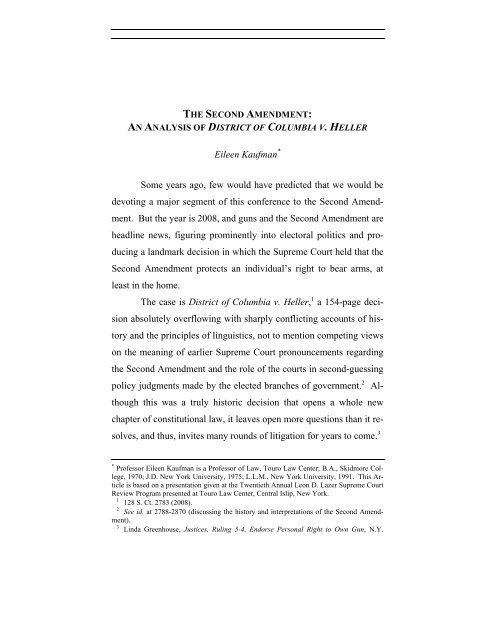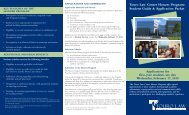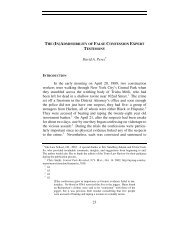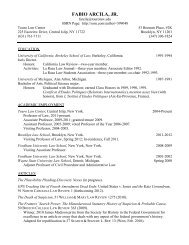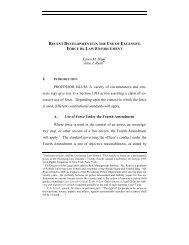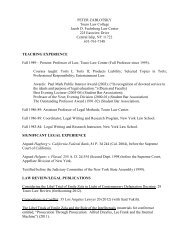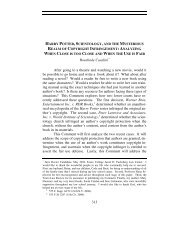the second amendment - Touro Law Center
the second amendment - Touro Law Center
the second amendment - Touro Law Center
- No tags were found...
You also want an ePaper? Increase the reach of your titles
YUMPU automatically turns print PDFs into web optimized ePapers that Google loves.
THE SECOND AMENDMENT:AN ANALYSIS OF DISTRICT OF COLUMBIA V. HELLEREileen Kaufman *Some years ago, few would have predicted that we would bedevoting a major segment of this conference to <strong>the</strong> Second Amendment.But <strong>the</strong> year is 2008, and guns and <strong>the</strong> Second Amendment areheadline news, figuring prominently into electoral politics and producinga landmark decision in which <strong>the</strong> Supreme Court held that <strong>the</strong>Second Amendment protects an individual’s right to bear arms, atleast in <strong>the</strong> home.The case is District of Columbia v. Heller, 1 a 154-page decisionabsolutely overflowing with sharply conflicting accounts of historyand <strong>the</strong> principles of linguistics, not to mention competing viewson <strong>the</strong> meaning of earlier Supreme Court pronouncements regarding<strong>the</strong> Second Amendment and <strong>the</strong> role of <strong>the</strong> courts in <strong>second</strong>-guessingpolicy judgments made by <strong>the</strong> elected branches of government. 2 Althoughthis was a truly historic decision that opens a whole newchapter of constitutional law, it leaves open more questions than it resolves,and thus, invites many rounds of litigation for years to come. 3* Professor Eileen Kaufman is a Professor of <strong>Law</strong>, <strong>Touro</strong> <strong>Law</strong> <strong>Center</strong>; B.A., Skidmore College,1970; J.D. New York University, 1975; L.L.M., New York University, 1991. This Articleis based on a presentation given at <strong>the</strong> Twentieth Annual Leon D. Lazer Supreme CourtReview Program presented at <strong>Touro</strong> <strong>Law</strong> <strong>Center</strong>, Central Islip, New York.1128 S. Ct. 2783 (2008).2See id. at 2788-2870 (discussing <strong>the</strong> history and interpretations of <strong>the</strong> Second Amendment).3Linda Greenhouse, Justices, Ruling 5-4, Endorse Personal Right to Own Gun, N.Y.
704 TOURO LAW REVIEW [Vol. 25The issue in <strong>the</strong> case was <strong>the</strong> constitutionality of WashingtonD.C.’s gun control law, considered <strong>the</strong> strictest in <strong>the</strong> country. 4 Thelaw prohibits <strong>the</strong> possession of handguns and requires that o<strong>the</strong>r firearmsin <strong>the</strong> home be disassembled or secured by a trigger lock. 5 Ino<strong>the</strong>r words, <strong>the</strong> law requires that all firearms in <strong>the</strong> home be renderedinoperable. The constitutionality of <strong>the</strong> law, of course, is dependenton <strong>the</strong> larger issue of whe<strong>the</strong>r <strong>the</strong> Second Amendment protectsan individual’s right to bear arms, or, whe<strong>the</strong>r it only guarantees<strong>the</strong> right to bear arms in connection with military service. The decisiondefinitively resolved that question, finding <strong>the</strong> Second Amendmentdoes protect an individual’s right to bear arms for personal use,but it offers very little guidance as to what kind of restrictions <strong>the</strong>government can place on that right. Additionally, it leaves unresolved<strong>the</strong> incorporation issue—whe<strong>the</strong>r <strong>the</strong> Second Amendment appliesto <strong>the</strong> states or only to <strong>the</strong> federal government. That basic questionwas not presented or resolved in Heller because at issue in Hellerwas a D.C. law, and <strong>the</strong> District of Columbia is a federal enclave.We must begin with <strong>the</strong> language of <strong>the</strong> Second Amendment,which is ra<strong>the</strong>r tortured, plagued by commas and unusually placedcapital letters: “[a] well regulated Militia, being necessary to <strong>the</strong> securityof a free State, <strong>the</strong> right of <strong>the</strong> people to keep and bear Arms,shall not be infringed.” 6 Three distinct interpretations of <strong>the</strong> SecondAmendment have been advanced over <strong>the</strong> years: 1) <strong>the</strong> “individualTIMES, June 27, 2008, at A1.4See Heller, 128 S. Ct. at 2788; D.C. CODE §§ 7-2501.01(12), 7-2502.01(a), 7-2502.02(a)(4) (2001).5D.C. CODE § 7-2507.02 (1976).6U.S. CONST. amend. II.
2009] DISTRICT OF COLUMBIA v. HELLER 705rights” model, which holds that <strong>the</strong> Amendment guarantees to individualcitizens <strong>the</strong> right to possess firearms for any lawful purposesubject to limited governmental regulation, 7 a view not adopted byany circuit court until 2001; 8 2) <strong>the</strong> “limited individual rights” model,also known as <strong>the</strong> “sophisticated collective rights” model, whichholds that <strong>the</strong> Amendment protects <strong>the</strong> individual’s right to beararms, but only in connection with militia service; 9 and 3) <strong>the</strong> “collectiverights” model, which holds that <strong>the</strong> Second Amendment protects<strong>the</strong> right of <strong>the</strong> state to arm its militia (this is <strong>the</strong> model, that untilJune 2008, dominated). 10As <strong>the</strong> headlines declared, <strong>the</strong> individual rights modelemerged from a sharply divided five-to-four Supreme Court lastterm, 11 with Justice Scalia writing what some consider to be his singlemost significant opinion in twenty-two years on <strong>the</strong> bench. Indeed,one commentator referred to it as “<strong>the</strong> magnum opus of JusticeScalia’s tenure on <strong>the</strong> Court.” 12Justice Scalia analyzed virtually every one of <strong>the</strong> twentysevenwords contained in <strong>the</strong> Second Amendment. He divided <strong>the</strong>7See Parker v. Dist. of Columbia, 478 F.3d 370, 379 (D.C. Cir. 2007).8Heller, 128 S. Ct. at 2823 n.2 (“Until <strong>the</strong> Fifth Circuit’s decision in United States v. Emerson,270 F.3d 203 (2001), every Court of Appeals to consider <strong>the</strong> question had understood. . . that <strong>the</strong> Second Amendment does not protect <strong>the</strong> right to possess and use guns for . . .civilian purposes.”).9Robert A. Levy, Reviving <strong>the</strong> Second Amendment, CATO INST., Oct. 27, 2001,http://www.cato.org/pub_display/php?pub_id=3859.10Parker, 478 F.3d at 379.11See, e.g., Robert Barnes, Justices Reject D.C. Ban on Handgun Ownership—5-4 RulingFinds 1976 <strong>Law</strong> Incompatible With Second Amendment, WASH. POST, June 27, 2008, at A1(“The [C]ourt’s landmark 5 to 4 decision split along ideological grounds and wiped awayyears of lower court decisions that had held that <strong>the</strong> intent of <strong>the</strong> <strong>amendment</strong>, ratified morethan 200 years ago, was to tie <strong>the</strong> right of gun possession to militia service.”).12Colloquy, Sizing up <strong>the</strong> 2007-08 Supreme Court Term, 31 LEGAL TIMES 9 (2008).
706 TOURO LAW REVIEW [Vol. 25text into its prefatory clause and its operative clause. 13 A lot of this islinguistics, and indeed, Justice Scalia relied on an amicus brief submittedby professors of linguistics to conclude that <strong>the</strong> prefatoryclause—“[a] well regulated Militia, being necessary to . . . a freeState”—merely announces a purpose. 14 In o<strong>the</strong>r words, it could berephrased as “because a well regulated Militia is necessary to <strong>the</strong> securityof a free State.” It states a purpose, but it does not control <strong>the</strong>meaning of <strong>the</strong> operative clause. Justice Scalia relied on <strong>the</strong> rule ofconstruction that a preamble cannot control <strong>the</strong> enacting part of <strong>the</strong>law, unless <strong>the</strong> enacting part is ambiguous. 15 He illustrated this pointby providing <strong>the</strong> following example: “[t]he separation of church andstate being an important objective, <strong>the</strong> teachings of canons shall haveno place in our jurisprudence.” 16 He said <strong>the</strong> prefatory clause wouldbe used to make clear that <strong>the</strong> word “canons” in <strong>the</strong> operative clauserefers to <strong>the</strong> canons of clergy as opposed to <strong>the</strong> canons of interpretation.17 But <strong>the</strong> Second Amendment’s operative clause contains nocomparable ambiguity, so <strong>the</strong> prefatory clause plays no role beyondmerely stating a purpose.Justice Scalia <strong>the</strong>n parsed <strong>the</strong> meaning of <strong>the</strong> operative clause:“<strong>the</strong> right of <strong>the</strong> people to keep and bear Arms, shall not be infringed.”18 He first addressed who is <strong>the</strong> holder of that right and13Heller, 128 S. Ct. at 2789.14Id. See U.S. CONST. amend. II; Brief for Professors of Linguistics and English DennisE. Baron, Ph.D., et al. as Amici Curiae Supporting Petitioners, Heller, 128 S. Ct. 2783 (No.07-290), 2008 WL 157194 at *3.15Heller, 128 S. Ct. at 2789.16Id.17Id.18Id. at 2789-90; U.S. CONST. amend. II.
2009] DISTRICT OF COLUMBIA v. HELLER 707concluded that “<strong>the</strong> right of <strong>the</strong> people” means <strong>the</strong> people as individuals,not as a collective. 19 He <strong>the</strong>n addressed <strong>the</strong> substance of <strong>the</strong>right—“to keep and bear arms”—and concluded “keep and bear”means to have and carry weapons outside of an organized militia. 20 Itprotects <strong>the</strong> “individual right to possess and carry weapons in case ofconfrontation.” 21 What is <strong>the</strong> meaning of <strong>the</strong> word “arms”? “Arms”means weapons and not just those designed for military use or in existencein <strong>the</strong> eighteenth century. “We do not interpret Constitutionalrights that way,” Justice Scalia declared. 22 If we did, <strong>the</strong>n <strong>the</strong> FirstAmendment would not apply to modern forms of communication,and <strong>the</strong> Fourth Amendment would not apply to modern forms ofsearches. 23Justice Scalia is characteristically sharply critical of <strong>the</strong> dissent’sinterpretation, which would limit “bear arms” to <strong>the</strong> militarycontext. In fact, he devoted a substantial portion of his opinion refuting<strong>the</strong> dissent’s linguistic analysis, which, according to JusticeScalia, is “unknown this side of <strong>the</strong> looking glass.” 24The majority relied not just on <strong>the</strong> text of <strong>the</strong> SecondAmendment, but also on history to support <strong>the</strong> conclusion that <strong>the</strong>operative clause protects <strong>the</strong> individual right to bear arms. 25 The historicalbackground of <strong>the</strong> Second Amendment is relevant, Justice19Heller, 128 S. Ct. at 2790.20Id. at 2792.21Id. at 2797.22Id. at 2791-92 (“[T]he Second Amendment extends, prima facie, to all instruments thatconstitute bearable arms, even those that were not in existence at <strong>the</strong> time of <strong>the</strong> founding.”).23Id.24Heller, 128 S. Ct. at 2795.25Id. at 2797.
708 TOURO LAW REVIEW [Vol. 25Scalia explained, because like <strong>the</strong> First and Fourth Amendments, <strong>the</strong>Second Amendment merely codified a pre-existing right. 26 In thisportion of his opinion, he extensively reviewed centuries of history,going back to <strong>the</strong> abuses of <strong>the</strong> Stuart Kings in <strong>the</strong> mid-seventeenthcentury, kings who would select militias loyal to <strong>the</strong>m to suppress politicaldissidents by disarming <strong>the</strong>m. 27 For example, King James II, aCatholic, ordered <strong>the</strong> disarmament of his Protestant enemies. Thesepractices led to <strong>the</strong> assurance in 1689, which was eventually codifiedin <strong>the</strong> English Bill of Rights, “[t]hat <strong>the</strong> subjects which are Protestantsmay have arms for <strong>the</strong>ir defense suitable to <strong>the</strong>ir conditions andas allowed by law.” 28 Blackstone, who is extensively cited in <strong>the</strong>opinion, later referred to this as “one of <strong>the</strong> fundamental rights ofEnglishmen.” 29 Indeed, a century later, American colonists reacted toKing George III’s attempt to disarm <strong>the</strong>m by relying on “<strong>the</strong>ir rightsas Englishmen to keep arms” for <strong>the</strong>ir own defense. 30The right that this history gave rise to, according to <strong>the</strong> majority,was <strong>the</strong> right of <strong>the</strong> individual “to possess and carry weapons incase of confrontation,” an individual right, not a right confined to <strong>the</strong>militia. 31 Understood in this manner, <strong>the</strong> prefatory clause fits perfectly,because “history show[s] that <strong>the</strong> way tyrants had eliminated amilitia . . . was not by banning <strong>the</strong> militia but simply by taking away<strong>the</strong> people’s arms, enabling a select militia or standing army to sup-26Id.27Id. at 2798 (“[T]he Stuart Kings Charles II and James II succeeded in using select militiasloyal to <strong>the</strong>m to suppress political dissidents, in part by disarming <strong>the</strong>ir opponents.”).28Heller, 128 S. Ct. at 2798 (internal quotes omitted).29Id.30Id. at 2799.31Id. at 2797.
2009] DISTRICT OF COLUMBIA v. HELLER 709press political opponents.” 32 The prefatory clause merely announces<strong>the</strong> purpose for which <strong>the</strong> right was codified: to prevent eliminationof <strong>the</strong> militia. This interpretation is, according to <strong>the</strong> majority, alsosupported by comparable provisions in state constitutions. 33The majority <strong>the</strong>n exhaustively examined how <strong>the</strong> SecondAmendment had been interpreted in each era since its enactment andconcluded that <strong>the</strong> interpretation in every stage of history supported<strong>the</strong> individual rights approach, with <strong>the</strong> exception of one lonely nineteenthcentury commentator who interpreted <strong>the</strong> Second Amendment’sright to bear arms as restricted to <strong>the</strong> militia. 34One aspect of this historical analysis I found particularly interestingrelated to what went on in <strong>the</strong> post-Civil War period, when<strong>the</strong>re was considerable discussion of <strong>the</strong> Second Amendment as it relatedto <strong>the</strong> newly freed slaves. 35 Many states, including, for example,Kentucky and South Carolina, were disarming <strong>the</strong> recently freedslaves. 36 Indeed, <strong>the</strong> 1866 Freedmen’s Bureau Act included a provisionthat guaranteed <strong>the</strong> right to have full and equal benefit of alllaws, including <strong>the</strong> constitutional right to bear arms to all citizens“without respect to race or color, or previous condition” of servitude.37 Having concluded that linguistics and history both support anindividual rights model, Justice Scalia <strong>the</strong>n analyzed whe<strong>the</strong>r <strong>the</strong> in-32Id. at 2801.33Heller, 128 S. Ct. at 2802-03 (noting Pennsylvania, Vermont, North Carolina, andGeorgia were among <strong>the</strong> first states to provide <strong>the</strong> individual with <strong>the</strong> right to bear arms).34Id. at 2807.35See id. at 2809-12.36Id. at 2810.37Id.
710 TOURO LAW REVIEW [Vol. 25dividual rights interpretation is consistent with earlier Supreme Courtpronouncements. 38 In what to me is <strong>the</strong> least convincing portion of<strong>the</strong> majority opinion, Justice Scalia concluded that <strong>the</strong> individualrights interpretation is fully consistent with precedent, even UnitedStates v. Miller, 39 a 1939 case widely viewed as rejecting <strong>the</strong> individualrights approach. In Miller, <strong>the</strong> Court upheld a federal convictionfor transporting an unregistered short-barreled shotgun in interstatecommerce in violation of <strong>the</strong> National Firearms Act. 40 The MillerCourt rejected a Second Amendment challenge stating:[i]n <strong>the</strong> absence of any evidence tending to show thatpossession or use of a ‘shotgun . . .’ at this time hassome reasonable relationship to <strong>the</strong> preservation or efficiencyof a well regulated militia, we cannot say that<strong>the</strong> Second Amendment guarantees <strong>the</strong> right to keepand bear such an instrument. 41Justice Scalia read Miller as merely standing for <strong>the</strong> proposition that<strong>the</strong> Second Amendment does not protect those weapons not typicallypossessed by law-abiding citizens for lawful purposes, weapons suchas short-barreled shotguns. 42 What about <strong>the</strong> “hundreds of judges”who had read Miller quite differently, as rejecting <strong>the</strong> individualrights approach? Justice Scalia believed <strong>the</strong>y simply misread Miller,and “<strong>the</strong>ir erroneous reliance upon an uncontested and virtually unreasonedcase cannot nullify <strong>the</strong> reliance of millions of Americans . .3839404142See Heller, 128 S. Ct. at 2812-16.307 U.S. 174 (1939). See also Heller, 128 S. Ct. at 2813-14.Miller, 307 U.S. at 174, 177, 183.Id. at 178.Heller, 128 S. Ct. at 2814.
2009] DISTRICT OF COLUMBIA v. HELLER 711. upon <strong>the</strong> true meaning of <strong>the</strong> right to keep and bear arms.” 43Justice Scalia also pointed out that it is not surprising <strong>the</strong> truemeaning of <strong>the</strong> Second Amendment has gone unresolved for so long,because for most of our constitutional history, <strong>the</strong> Bill of Rights wasthought to be inapplicable to <strong>the</strong> states, and <strong>the</strong> federal governmentrarely regulated “possession of firearms by law-abiding citizens.”Thus, “[f]or most of our history <strong>the</strong> question did not present itself.” 44That brings us to <strong>the</strong> District of Columbia statute and <strong>the</strong>question of <strong>the</strong> extent to which <strong>the</strong> individual right to bear arms issubject to state regulation. There is little dispute that <strong>the</strong> right is notabsolute, just as <strong>the</strong> right to free speech is not absolute, or <strong>the</strong> right toreproductive freedom is not absolute. But, to what extent <strong>the</strong> SecondAmendment right to bear arms is subject to regulation is a questionthat prompted a schism even among proponents of <strong>the</strong> individualrights model. Paul Clement, <strong>the</strong> Solicitor General, took a position atodds with o<strong>the</strong>r members of <strong>the</strong> Bush Administration, and he wasroundly criticized for it. 45 He argued <strong>the</strong> Second Amendment permittedreasonable regulation of firearms, for example, federal regulationof machine guns, and <strong>the</strong> Court should not apply strict scrutiny to reviewgun regulation. 46 Unfortunately, <strong>the</strong> Court declined to provideany meaningful guidance as to how to measure <strong>the</strong> constitutionalityof gun control laws, which means <strong>the</strong> litigation has only just begun. 4743Id. at 2815 n.24.44Id. at 2816.45See id. at 2814.46Brief for <strong>the</strong> United States as Amici Curiae Supporting Respondent, Heller, 128 S. Ct.2783 (No. 07-290), 2008 WL 157201 at *21, 24-25.47Heller, 128 S. Ct. at 2821.
712 TOURO LAW REVIEW [Vol. 25Here is what <strong>the</strong> Court did say. First, <strong>the</strong> right secured by <strong>the</strong>Second Amendment is not absolute. Indeed, nineteenth centurycourts routinely upheld restrictions on <strong>the</strong> right, such as “prohibitionson carrying concealed weapons.” 48 The Court also indicated that <strong>the</strong>following regulatory measures would all be constitutional: “prohibitionson <strong>the</strong> possession of firearms by felons and <strong>the</strong> mentally ill, orlaws forbidding <strong>the</strong> carrying of firearms in sensitive places such asschools and government buildings, or laws imposing conditions andqualifications on <strong>the</strong> commercial sale of arms.” 49 But, we are givenabsolutely no explanation of why those restrictions are constitutionalnor any standard by which we can determine what o<strong>the</strong>r regulationswould be constitutional. 50A <strong>second</strong> limitation on <strong>the</strong> right to bear arms, derived fromMiller, is that “<strong>the</strong> Second Amendment does not protect those weaponsnot typically possessed by law-abiding citizens for lawful purposes.”51 This limitation has interesting implications. It means <strong>the</strong>weapons most used in military service, weapons like M-16 rifles,may be banned. These weapons are not protected by <strong>the</strong> SecondAmendment because <strong>the</strong>y are not typically possessed by law-abidingcitizens for lawful purposes, even though <strong>the</strong>y are most useful inmilitary service today. Does that not defeat <strong>the</strong> purpose expressed in<strong>the</strong> Second Amendment’s prefatory clause? If <strong>the</strong> purpose of <strong>the</strong>Second Amendment is to prevent elimination of <strong>the</strong> militia, it is cer-48495051Id. at 2816.Id. at 2816-17.See id. at 2846 (Stevens, J., dissenting); see id. at 2851 (Breyer, J., dissenting).Heller, 128 S. Ct. at 2815-16 (majority opinion).
2009] DISTRICT OF COLUMBIA v. HELLER 713tainly ra<strong>the</strong>r anomalous to interpret <strong>the</strong> Amendment as not protecting<strong>the</strong> weapons most likely to be used by a militia. Justice Scalia candidlyacknowledged that his interpretation does indeed produce thispeculiar result. 52 His response was merely to note that “<strong>the</strong> fact thatmodern developments have limited <strong>the</strong> degree of fit between <strong>the</strong>prefatory clause and <strong>the</strong> protected right cannot change our interpretationof <strong>the</strong> right.” 53What does this mean for <strong>the</strong> D.C. law? Remember, <strong>the</strong> ordinancedoes two things: it prohibits handgun possession in <strong>the</strong> home,and it requires o<strong>the</strong>r firearms in <strong>the</strong> home be rendered inoperable.Both provisions violate <strong>the</strong> Second Amendment. The handgun prohibitionis unconstitutional because it is a wholesale prohibition of<strong>the</strong> type of gun considered by <strong>the</strong> American people to be <strong>the</strong> quintessentialself-defense weapon, and “[t]he prohibition extends . . . to <strong>the</strong>home, where <strong>the</strong> need for defense of self, family, and property ismost acute.” 54 The <strong>second</strong> provision requiring all “firearms in <strong>the</strong>home be rendered and kept inoperable at all times” is also unconstitutionalbecause “[t]his makes it impossible for citizens to use [<strong>the</strong>weapon] for <strong>the</strong> core lawful purpose of self-defense.” 55Although a considerable portion of <strong>the</strong> oral argument hadbeen devoted to <strong>the</strong> question of what governing standard should beused to evaluate gun restrictions, <strong>the</strong> majority, unfortunately, declinedto announce what level of scrutiny applies; it did, however, re-52535455Id. at 2817.Id.Id. at 2817.Id. at 2818.
714 TOURO LAW REVIEW [Vol. 25ject rational basis as <strong>the</strong> governing standard and reject JusticeBreyer’s proffered interest-balancing approach. 56 Justice Scalia arguedthat since this is <strong>the</strong> Court’s first foray into <strong>the</strong> field we shouldnot expect <strong>the</strong> Court “to clarify <strong>the</strong> entire field.” 57 This view reflects<strong>the</strong> comment Justice Roberts made at oral argument: “[i]’m not surewhy we have to articulate some very intricate standard. . . . I don’tknow why when we are starting afresh, we would try to articulate awhole standard that would apply in every case?” 58All we know for sure from this ground-breaking decision isthat laws that prohibit possessing loaded firearms in <strong>the</strong> home forself-defense violate <strong>the</strong> Second Amendment; but, laws prohibitingconcealed weapons do not; laws prohibiting <strong>the</strong> possession of firearmsby felons and <strong>the</strong> mentally ill do not; laws forbidding guns inschools and government buildings do not; and laws imposing conditionsand qualifications on commercial sale of arms do not. Fur<strong>the</strong>r,since Justice Scalia seems to have interpreted <strong>the</strong> Second Amendmentas not applying to weapons not customarily possessed by lawabidingcitizens, <strong>the</strong> federal ban on possessing machine guns wouldpresumably be upheld.Let us spend a few minutes on <strong>the</strong> dissents. There were two:one by Justice Stevens, focusing primarily on <strong>the</strong> meaning of <strong>the</strong>56Heller, 128 S. Ct. at 2821 (“[The] ‘interest-balancing inquiry’ asks whe<strong>the</strong>r <strong>the</strong> statuteburdens a protected interest in a way or to an extent that is out of proportion to <strong>the</strong> statute’ssalutary effects upon o<strong>the</strong>r important governmental interests.”) (citations and internal quotationsomitted).57Id.58Transcript of Oral Argument, Heller, 128 S. Ct. 2783 (No. 07-290), 2008 WL 731297 at*44.
law.” 62 Like Justice Scalia, Justice Stevens closely parsed <strong>the</strong> text of2009] DISTRICT OF COLUMBIA v. HELLER 715Second Amendment; 59 and one by Justice Breyer, focusing exclusivelyon <strong>the</strong> standard <strong>the</strong> Court should use in determining whe<strong>the</strong>r aparticular gun control law violates <strong>the</strong> Second Amendment. 60Justice Stevens wrote a vigorous dissent in which he said <strong>the</strong>Second Amendment does not confer an individual right to bear arms,but ra<strong>the</strong>r, it was “today’s law-changing decision” that accomplishedthis result. 61 He characterized <strong>the</strong> majority’s interpretation of <strong>the</strong>Second Amendment as overwrought, novel, “strained and unpersuasive,”and he said that “[e]ven if . . . arguments on both sides of <strong>the</strong>issue were evenly balanced,” principles of stare decisis “would preventmost jurists from endorsing such a dramatic upheaval in <strong>the</strong><strong>the</strong> Second Amendment and painstakingly examined precedent andhistory. Like Justice Scalia, Justice Stevens relied on state declarationsand constitutional provisions; but, unlike Justice Scalia, JusticeStevens concluded that <strong>the</strong>y show that <strong>the</strong> Second Amendment wasnot meant to protect civilian use of weapons. 63 For example, hepointed to <strong>the</strong> declarations of rights of Pennsylvania and Vermont,both of which expressly protect <strong>the</strong> civilian’s “right to use firearmsfor hunting or personal self-defense.” 64 Justice Stevens also pointedto <strong>the</strong> many formulations of <strong>the</strong> Second Amendment that James596061626364See generally Heller, 128 S. Ct. at 2822-48 (Stevens, J., dissenting).See id. at 2847-70 (Breyer, J., dissenting).Id. at 2846 (Stevens, J., dissenting).Id. at 2823, 2824; see id. at 2826, 2828, 2831.See id. at 2825, 2831.Heller, 128 S. Ct. at 2825 (Stevens, J., dissenting).
716 TOURO LAW REVIEW [Vol. 25Madison, its drafter, considered and rejected, including versions thatexplicitly protected nonmilitary, civilian use of weapons. 65 He reliedon a conscientious objector clause that Madison included in <strong>the</strong> originaldraft of <strong>the</strong> Second Amendment as fur<strong>the</strong>r evidence of <strong>the</strong> viewthat <strong>the</strong> right to bear arms was limited to military service. 66 To JusticeStevens, <strong>the</strong> history of <strong>the</strong> adoption of <strong>the</strong> Second Amendmentunmistakably demonstrated that <strong>the</strong> overriding concern that led to <strong>the</strong>adoption of <strong>the</strong> Amendment was<strong>the</strong> potential threat to state sovereignty that a federalstanding army would pose, and a desire to protect <strong>the</strong>States’ militias as <strong>the</strong> means by which to guard againstthat danger. But state militias could not effectivelycheck <strong>the</strong> prospect of a federal standing army so longas Congress retained <strong>the</strong> power to disarm <strong>the</strong>m, and soa guarantee against such disarmament was needed. 67Thus, <strong>the</strong> historical analysis demonstrated that <strong>the</strong> framers of <strong>the</strong>Second Amendment had a single purpose in mind—<strong>the</strong> preservationof <strong>the</strong> militia—and <strong>the</strong> framers did not intend to limit <strong>the</strong> ability ofCongress to regulate <strong>the</strong> civilian use of weapons.Justice Stevens criticized <strong>the</strong> majority for denigrating and ignoring<strong>the</strong> importance of <strong>the</strong> prefatory clause. He wrote:[w]ithout identifying any language in <strong>the</strong> text thateven mentions civilian uses of firearms, <strong>the</strong> Court proceedsto “find” its preferred reading in what is at bestan ambiguous text, and <strong>the</strong>n concludes that its readingis not foreclosed by <strong>the</strong> preamble. Perhaps <strong>the</strong> Court’s656667Id. at 2835.Id. at 2835-36.Id. at 2836.
2009] DISTRICT OF COLUMBIA v. HELLER 717approach to <strong>the</strong> text is acceptable advocacy, but it issurely an unusual approach for judges to follow. 68Justice Stevens is also harshly critical of <strong>the</strong> Court’s pronouncementthat <strong>the</strong> right “ ‘to keep and bear arms’ ” protects <strong>the</strong>right in cases of confrontation, not <strong>the</strong> “right to possess arms for‘lawful, private purposes,’ ” which is how <strong>the</strong> D.C. Court of Appealshad interpreted <strong>the</strong> Second Amendment. 69 Justice Stevens stated,“[n]o party or amicus urged this interpretation; <strong>the</strong> Court appears tohave fashioned it out of whole cloth.” 70He analogized Justice Scalia’s word-for-word parsing of <strong>the</strong>Second Amendment to <strong>the</strong> parable of <strong>the</strong> six blind men and <strong>the</strong> elephant:a blind man touches one part and decides it is a tree, and ano<strong>the</strong>rman touches a different part and concludes it is a snake, and soon. 71 The point, of course, is a failure to fundamentally grasp <strong>the</strong> natureof <strong>the</strong> beast. The nature of <strong>the</strong> Second Amendment <strong>the</strong> majorityfailed to grasp, according to Justice Stevens, is that <strong>the</strong> SecondAmendment “secure[s] to <strong>the</strong> people a right to use and possess armsin conjunction with service in a well-regulated militia.” 72There are many sharp differences between <strong>the</strong> majority and<strong>the</strong> dissent, but <strong>the</strong> most pointed concerns <strong>the</strong> meaning of Miller,which as Justice Stevens pointed out, had been interpreted by courtsand commentators alike to signify a rejection of <strong>the</strong> individual rights6869707172Id. at 2826.Heller, 128 S. Ct. at 2828 (Stevens, J., dissenting).Id. at 2828.Id. at 2831 n.14.Id. at 2831.
erect?” 77 In an attempt to answer that question, he relied on historical718 TOURO LAW REVIEW [Vol. 25model of <strong>the</strong> Second Amendment. 73 The majority’s reinterpretationof Miller, Justice Stevens said, represents a lack of “respect for <strong>the</strong>well-settled views of all of our predecessors on this Court, and for <strong>the</strong>rule of law itself.” 74Justice Breyer’s dissenting opinion focused exclusively on <strong>the</strong>question of how a Court should go about determining <strong>the</strong> constitutionalityof a particular firearm regulation. 75 Assuming <strong>the</strong> SecondAmendment protects an individual right to bear arms, “what kind ofconstitutional standard should <strong>the</strong> court use” in evaluating gun regulations?76 “How high a protective hurdle does <strong>the</strong> Amendmentevidence showing gun regulation is consistent with <strong>the</strong> SecondAmendment. He described laws in effect in colonial times, whichsignificantly limited firearms in urban areas. New York City, for example,imposed severe restrictions on how gunpowder could bestored in <strong>the</strong> home. 78Ultimately, <strong>the</strong> standard Justice Breyer proposed was an interest-balancingapproach, similar to <strong>the</strong> analysis used in proceduraldue process cases or cases involving government employees’speech. 79 This analysis would balance competing interests and con-73See id. at 2822-23, 2839.74Heller, 128 S. Ct. at 2824 (Stevens, J., dissenting).75See id. at 2850-55 (Breyer, J., dissenting).76Id. at 2851.77Id.78Id. at 2850 (citing Act of April 13, 1784, ch. 28, 1784 N.Y. <strong>Law</strong>s p. 627).79Heller, 128 S. Ct. at 2852-53 (supporting <strong>the</strong> use of an interest-balancing approach indetermining <strong>the</strong> constitutionality of <strong>the</strong> District of Columbia handgun law). See also
2009] DISTRICT OF COLUMBIA v. HELLER 719sider whe<strong>the</strong>r <strong>the</strong>re are less restrictive alternatives. Applying that approachto <strong>the</strong> DC law, Justice Breyer found that it was a proportionateresponse to compelling life-preserving, public-safety intereststhat did not disproportionately burden <strong>the</strong> interests which <strong>the</strong> SecondAmendment was designed to protect. 80 To <strong>the</strong> extent that <strong>the</strong> SecondAmendment was primarily designed to preserve <strong>the</strong> militia, <strong>the</strong>re isabsolutely nothing in <strong>the</strong> DC law that burdens that interest. 81 The respondent,Dick Heller, is 66 years old and even in <strong>the</strong> unlikely eventthat <strong>the</strong> District of Columbia were to call upon its citizenry to form amilitia, respondent’s service would not be requested. 82 A <strong>second</strong> interestthat arguably could be encompassed in <strong>the</strong> Second Amendmentis an interest in hunting. However, <strong>the</strong> DC law does not prohibit possessingrifles or shotguns, so that interest is not burdened. 83 What isburdened by <strong>the</strong> DC law is <strong>the</strong> interest in keeping a loaded handgunin <strong>the</strong> home for purposes of self-defense. Justice Breyer examinedwhe<strong>the</strong>r <strong>the</strong>re are less restrictive alternatives, and he concluded that<strong>the</strong>re are none, because what makes handguns so useful for selfdefenseis precisely what makes <strong>the</strong>m particularly dangerous. 84Justice Breyer criticized <strong>the</strong> majority for severely limiting <strong>the</strong>ability of democratically elected legislatures to deal with gun-relatedMa<strong>the</strong>ws v. Eldridge, 424 U.S. 319, 334-35 (1976) (utilizing an interest-balancing approachin analyzing a procedural due process claim); Pickering v. Bd. of Educ. of Twp. High Sch.Dist. 205, 391 U.S. 563, 568 (1968) (advancing an interest-balancing approach to ascertain<strong>the</strong> constitutional limits of government employees’ speech).80Heller, 128 S. Ct. at 2861, 2865.81Id. at 2861.82Id. at 2861-62.83Id. at 2863.84Id. at 2864.
720 TOURO LAW REVIEW [Vol. 25problems. 85 He argued that courts should show more deference tolegislative judgment because of <strong>the</strong>ir better fact-finding capacity. Hesaid:I can understand how reasonable individuals can disagreeabout <strong>the</strong> merits of strict gun control as a crimecontrolmeasure, even in a totally urbanized area. ButI cannot understand how one can take from <strong>the</strong> electivebranches of government <strong>the</strong> right to decidewhe<strong>the</strong>r to insist upon a handgun-free urban populacein a city now facing a serious crime problem andwhich, in <strong>the</strong> future, could well face environmental oro<strong>the</strong>r emergencies that threaten <strong>the</strong> breakdown of lawand order. 86Finally, Justice Breyer described <strong>the</strong> unfortunate consequencesof <strong>the</strong> majority’s decision. By failing to provide clear standards,<strong>the</strong> majority opinion “will encourage legal challenges to gunregulation throughout <strong>the</strong> nation.” 87 He said “litigation over <strong>the</strong>course of many years, or <strong>the</strong> mere specter of such litigation, threatensto leave cities without effective protection against gun violence andaccidents during that time.” 88What was <strong>the</strong> reaction to this historic decision? PresidentBush and both presidential candidates expressed support for <strong>the</strong> decision.89 Indeed, both <strong>the</strong> Republican and Democratic platforms of85Heller, 128 S. Ct. at 2868 (Breyer, J., dissenting).86Id.87Id.88Id.89See Statement on <strong>the</strong> United States Supreme Court Ruling on Individual Gun Rights, 44WEEKLY COMP. PRES. DOC. 921 (June 26, 2008). President Bush declared: “As a longstandingadvocate of <strong>the</strong> rights of gun owners in America, I applaud <strong>the</strong> Supreme Court’s historicdecision today confirming what has always been clear in <strong>the</strong> Constitution: <strong>the</strong> Second
2009] DISTRICT OF COLUMBIA v. HELLER 7212008 recognized <strong>the</strong> Constitutional right to bear arms, although <strong>the</strong>two platforms offered radically different versions of <strong>the</strong> right. 90 TheRepublican platform specifically calls on <strong>the</strong> next president to appointjudges who will continue to respect <strong>the</strong> right, and who will oppose<strong>the</strong> federal licensing of law-abiding gun owners and nationalgun registration as violative of <strong>the</strong> Second Amendment. 91 The Democraticplatform embraces <strong>the</strong> right to bear arms as a part of <strong>the</strong>American tradition, but emphasizes <strong>the</strong> importance of reasonableregulations to keep communities safe. 92It has been less than four months since <strong>the</strong> Supreme Court announced<strong>the</strong> decision in Heller, but <strong>the</strong>re have already been literallydozens of cases where criminal defendants have attempted to have<strong>the</strong>ir convictions reversed on <strong>the</strong> strength of Heller. 93 In each casethus far, <strong>the</strong> courts have rejected <strong>the</strong> Second Amendment argument. 94All of <strong>the</strong> following gun laws have been upheld against a SecondAmendment protects an individual right to keep and bear firearms.” Id. See also Cass R.Sunstein, Second Amendment Minimalism: Heller as Griswold, 122 HARV. L REV. 246, 253,263 (2007) (recognizing Barack Obama’s and John McCain’s general enthusiasm for <strong>the</strong>Heller decision). Senator McCain said <strong>the</strong> decision was “a landmark victory for SecondAmendment freedom in <strong>the</strong> United States” that “ended forever <strong>the</strong> specious argument that<strong>the</strong> Second Amendment did not confer an individual right to keep and bear arms.” Postingof Tom Bevan to Real Clear Politics,http://www.realclearpolitics.com/politics_nation/2008/06/scotus_rules_for_guns.html (June26, 2008) (last visited April 5, 2009). Senator Obama praised <strong>the</strong> Court for finding that <strong>the</strong>right is not absolute, but is “subject to reasonable regulations enacted by local communitiesto keep <strong>the</strong>ir streets safe.” Id.90Compare 2008 Republican Platform—Values, http://www.gop.com/2008/Platform/(last visited Jan. 31, 2008), with The 2008 Democratic National Platform: Renewing America’sPromise, http://www.democrats.org/a/party/platform.html (last visited Jan. 31, 2008).912008 Republican Platform, supra note 90.922008 Democratic National Platform, supra note 90.93See, e.g., United States v. Guerrero-Leco, No. 3:08cr118, 2008 WL 4534226(W.D.N.C. Oct. 6, 2008); United States v. Westry, No. 08-20237, 2008 WL 4225541 (E.D.Mich. Sept. 9, 2008).94See, e.g., Guerrero-Leco, 2008 WL 4534226, at *1; Westry, 1008 WL 4225541, at * 2.
722 TOURO LAW REVIEW [Vol. 25Amendment attack: a law prohibiting possession of a firearm within athousand feet of a school; 95 a law prohibiting felons from possessingguns; 96 a law prohibiting gun possession by persons who have beenconvicted of a misdemeanor crime of domestic violence; 97 a law prohibitinggun possession on federal postal property; 98 a law prohibitingpossessing guns by an individual subject to an order of protection involvingdomestic abuse; 99 a law prohibiting <strong>the</strong> possession of asawed-off shotgun; 100 a law criminalizing traffic in stolen firearms; 101and a law prohibiting carrying a concealed weapon without a permit.102One case, a little out of <strong>the</strong> ordinary because it actually involveda militia, is United States v. Fincher, 103 where <strong>the</strong> Eighth Circui<strong>the</strong>ld <strong>the</strong> Second Amendment does not extend to machine guns orsawed-off shotguns used in connection with an unsanctioned militia.104 The defendant, Fincher, was convicted of violating federalstatutes which prohibit <strong>the</strong> possession of unregistered sawed-off95See United States v. Lewis, No. 2008-45, 2008 WL 5412013 (D.V.I. Dec. 24, 2008)(prohibiting possession near school zone).96See United States v. Abner, No. 3:08cr51-MHT, 2009 WL 103172 (M.D. Ala. Jan. 24,2009) (prohibiting possession by felons).97See United States v. Lippman, No. 4:02-cr-082, 2008 WL 46641514 (D.N.D. Oct. 20,2008) (prohibiting possession where <strong>the</strong>re is a domestic violence restraining order).98See United States v. Dorosan, No. 08-042, 2008 WL 2622996 (E.D. La. June 30, 2008)(prohibiting possession on postal property).99See United States v. White, No. 07-00361-WS, 2008 WL 3211298 (S.D. Ala. Aug. 6,2008) (prohibiting possession in domestic violence situations).100See United States v. Fincher, 538 F.3d 868 (8th Cir. Aug 13, 2008) (prohibiting possessionof sawed-off shotgun).101See LaRoche v. United States, Nos. CV 407-054, CR402-234, 2008 WL 4222081(S.D. Ga. Sept. 15, 2008) (criminalizing <strong>the</strong> traffic in stolen firearms).102See United States v. Davis, No. 05-50726, 2008 WL 4962926 (9th Cir. Sept. 10, 2008)(prohibiting concealed weapon).103538 F.3d at 868.104Fincher, 538 F.3d at 873-74.
2009] DISTRICT OF COLUMBIA v. HELLER 723shotguns and machine guns. 105 Fincher argued that his possession ofthose weapons was in connection with his membership in <strong>the</strong> WashingtonCounty Militia, a group that he helped found for <strong>the</strong> ostensiblereason of assisting local law enforcement, though he had been unsuccessfulin obtaining approval or any official sanction of <strong>the</strong> militia. 106The Eighth Circuit rejected his Second Amendment challenge, findingthat (a) his gun possession was not reasonably related to a wellregulatedmilitia, since <strong>the</strong> Washington County Militia was an unorganizedmilitia, and (b) drawing on Heller, since machine guns arenot in common use by law-abiding citizens for lawful purposes, <strong>the</strong>yare not within <strong>the</strong> protection of <strong>the</strong> Second Amendment. 107Clearly, gun control laws are at risk after Heller. A Chicagoordinance, which is considered <strong>the</strong> <strong>second</strong> strictest after Heller, bans<strong>the</strong> possession of handguns acquired after 1983 and requires <strong>the</strong> reregistrationof older guns every two years. A challenge to <strong>the</strong> Chicagolaw, McDonald v. City of Chicago, 108 was filed hours after <strong>the</strong>Heller decision was announced and that case directly presents <strong>the</strong> incorporationissue. In fact, Alan Gura, <strong>the</strong> same attorney who representedHeller, has said he is ready for that fight; McDonald is <strong>the</strong>case to resolve that. 109 Many Chicago suburbs also ban handgun possession,but most of those towns repealed <strong>the</strong>ir bans in <strong>the</strong> aftermathof Heller in an effort to avoid costly litigation. 110 Toledo, Ohio also105Id. at 870.106Id. at 871-72.107See id. at 872-74.108No. 08C3645, 2008 WL 5111112 (N.D. Ill. Dec. 4, 2008).109Interview by Glenn Beck with Alan Gura, in Washington, D.C. (June 26, 2008).110See Christopher Keleher, District of Columbia v. Heller: The Death Knell for IllinoisHandgun Bans?, 96 ILL. B.J. 402, 406 (2008).
724 TOURO LAW REVIEW [Vol. 25has a gun control law that may be vulnerable after Heller. 111The bottom line is that Heller is truly a landmark decision, butone certain to usher in a new era of gun litigation. The first roundwill be devoted to <strong>the</strong> question of incorporation—<strong>the</strong> threshold questionthat <strong>the</strong> Supreme Court will ultimately resolve. What follows, Isuspect, will be litigation throughout <strong>the</strong> nation attempting to tackle<strong>the</strong> thornier question of how to evaluate <strong>the</strong> constitutionality of firearmregulations. What standard should <strong>the</strong> courts use? How deferentialshould <strong>the</strong> courts be to legislative fact-finding? Although <strong>the</strong> SupremeCourt ducked that issue in Heller, it is only a matter of timeuntil <strong>the</strong> Court will have to establish <strong>the</strong> standard used to evaluategovernmental regulation of firearms.111See Heller, 128 S. Ct. at 2865.


